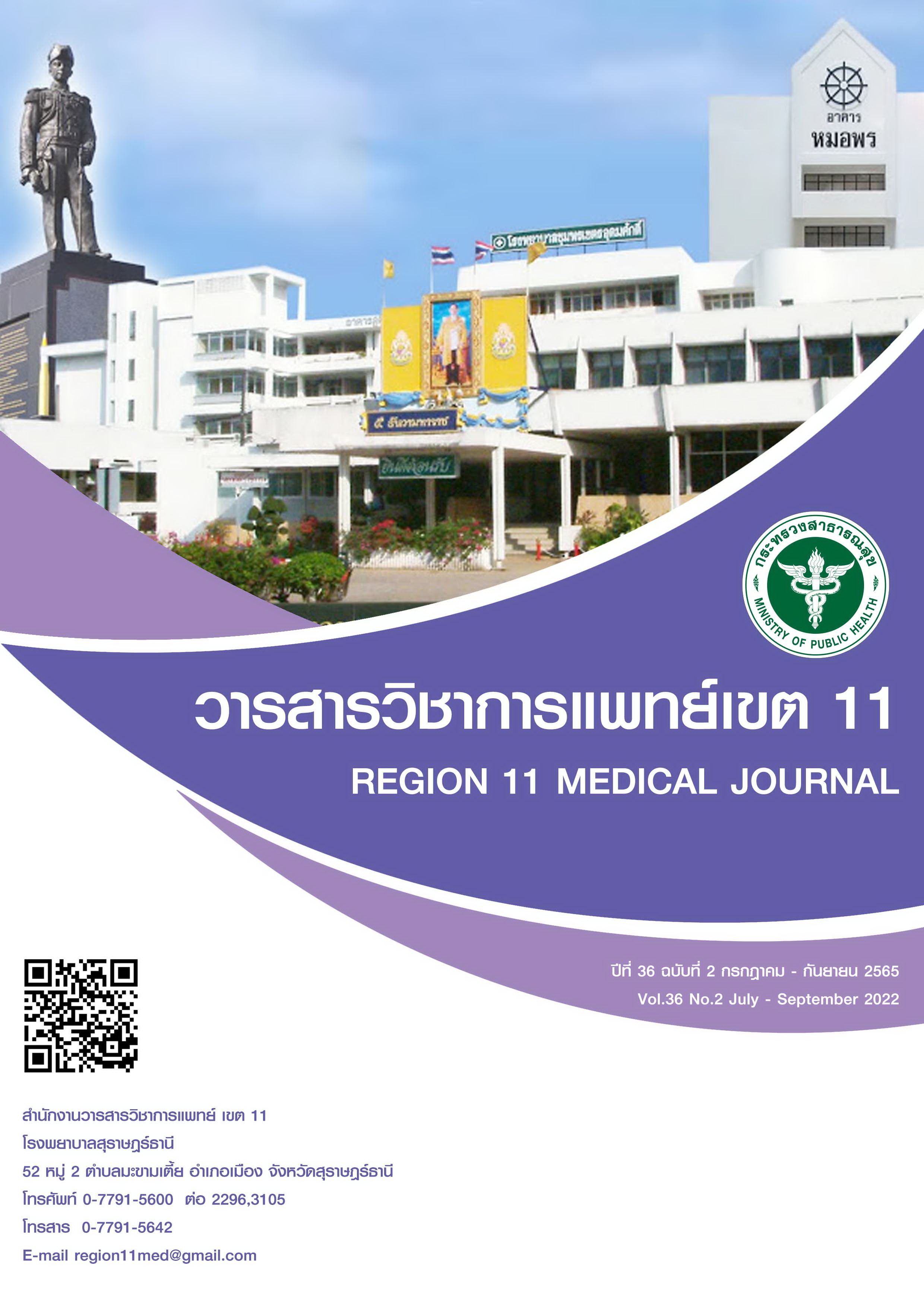Comparative Assessment of Intraocular Pressure Measurement Between Non-Contact tonometry and Goldmann Applanation Tonometry among Glaucoma Patients in Angthong Hospital
DOI:
https://doi.org/10.14456/reg11med.2022.11Keywords:
Intraocular pressure, Non-contact tonometry, Goldmann applanation tonometry, GlaucomaAbstract
Objective: To compare the intraocular pressure (IOP) values acquired from non-contact tonometry and a Goldmann applanation tonometry in glaucoma patients.
Design: A prospective, cross-sectional study
Methods: This study involved 400 eyes from 200 glaucoma patients who attended the glaucoma outpatient clinic, Angthong hospital during January 4th, 2021 to June 30th, 2021. IOP measurements were obtained using non-contact tonometry (NCT) and Goldmann applanation tonometry (GAT). The differences in intraocular pressure (IOP) readings between the two techniques were evaluated using paired t-test and calculating the Pearson correlation coefficient. A Bland-Altman analysis was used to determine the limit of agreement between the two techniques.
Results: The mean intraocular pressure as measured by NCT was 17.29 ± 4.21 mmHg, compare the mean intraocular pressure as measured by GAT was 16.50 ± 3.74 mmHg. The mean differences intraocular pressure readings between the two techniques were 0.79 ± 1.09 mmHg. There was a strong correlation between NCT and GAT finding in the right eye (r = 0.807, n = 200, P < 0.001) and in the left eye (r = 0.857, n = 200, P < 0.001). Bland-Altman plots, limit of agreement range from -3.88 to 5.81 mmHg in the right eye (mean = 0.95) and limit of agreement range from -3.67 to 4.92 mmHg in the left eye (mean = 0.62).
Conclusions: In this study found that NCT readings were significant difference and higher IOP readings of the GAT; but within the clinically acceptable inter device measure for IOP. The NCT and GAT measurements correlated positively. NCT can be used as a screening tool for IOP testing in the high volume clinic. However, NCT cannot replace the existing gold standard method for IOP measurement, the GAT.
References
Pascolini D. Global estimates of visual impairment: 2010. Br J Ophthalmol 2012;96:614-618.
Skalicky S, Goldberg I . Depression and quality of life in patients with glaucoma: a cross-sectional analysis using the Geriatric Depression Scale-15, assessment of function related to vision, and the Glaucoma quality of Life-15. J Glaucoma, 2008;17(7):546-51.
Quigley HA, Broman AT. The number of people with glaucoma worldwide in 2010 and 2020. Br J Ophthalmology 2006;9:262-7.
Tham YC, Li X, Wong TY, Quiqley HA, Aung T, Cheng CY. Global prevalence and projections of glaucoma burden through 2040: a systematic review and meta-analysis. Ophthalmology 2014; 121:2081-90.
American Academy of Ophthalmology. Basic and clinical science course section 10: glaucoma. San Francisco: American Academy of Ophthalmology; 2019.
Goel M, Picciani RG, Lee RK, Bhattacharya SK. Aqueous humor dynamics: a review Open ophthalmol J. 2010; 4:52-59.
Mitra AK, editor. Ophthalmic Drug Delivery Systems, 2nd ed. New york, NY: Marcel Dekker; 2003:224-2225.
Kita T, Lui JH, Weinreb RN. Effect of aging on corneal biomechanical properties and their impact on 24-hour measurement of intraocular pressure. Am J Ophthalmol 2008;146(4):567-672.
Topouzis F, Founti P. Weighing in ocular perfusion pressure in managing glaucoma. Open Ophthalmol J 2009;3:43-5
Kniestedt Cm Punjabi O, Lin S, Stamper RL. Tonometry through the ages. Suv Ophthalmol 2008;53:568-91
Goldmann HmSchmidt T. Applanation tonometry. Ophthalmologica 1957;134:221-42
Fleming J. Anterior segment evaluation: Applanation tonometrics. In: Benjamin WJ, Borish IM, editors Borish’s clinical refraction. 2nd ed. St, Louism MO: Butterworth-Heinemann:2006. P.501-3
Jampel H. Intraocular pressure and tonometry. In: Morrison JC, Pollack IP, editors. Glaucoma science and practice. New york, NY: Thieme Medical Publisher; 2003. p.57-69.
Crick RP, Kha PT. Disorder associated with the level of intraocular pressure. In: Crick RP, Khaw PT, editors. A textbook of clinical ophthalmology: A practical guide to disorder of the eyes and their management. 3rd ed. Singapore: world scientific; 2003. P 547-84.
Farhood QK. Comparative evaluation of intraocular pressure with an air-puff tonometer versus a Goldmann applanation tonometer. Clin ophthalmol 2013;7:23-7.
Firat PG,Cankaya C, Doganay S. The influence of soft contact lenses on the intraocular pressure measurement. Eye (Lond). 2012; 26(2):278-82.
Samuel Kyei, Cynthia Pakyennu Gboglu, Michael Agyemang Kwarteng. Comparative assessment of the Goldmann applanation and noncontact tonometers in intraocular pressure measurements in a sample of glaucoma patients in cape coast metropolis, Ghana. Nigeria medical journal. 2020;61:323-27.
Yildiz A, Yasar T. Comparison of Goldmann applanation, non-contact, dynamic contour and tonopen tonometry measurement in healthy and glaucomatous eyes, and effect of central corneal thickness on the measurement result. Med Glas(Zeneca) 2018;15:152-7.
Kouchaki B, Hashemi H, Yekta A, Khabazkhoob M. Comparison of current tonometry techniques in measurement of intraocular pressure. J Curr Ophthalmol 2017;29:92-7.
Martinez-de-la-Casa JM, Jimenez-Santos M, Saenz-France F, et al. Performance of the rebound, noncontact and Goldman applanation tonometers in routine clinical practice. Acta ophthalmol. 2011;89:676-80.
Garcia-Resua C, Giraldez Fernandez MJ, Yebra Pimentel E, Garcia-Montero S. Clinical evaluation of the canon TX-10 noncontact tonometer in healthy eye. Eur J Ophthalomol. 2010;20(3):530-30.
Downloads
Published
How to Cite
Issue
Section
License
Copyright (c) 2022 Region11Medical Journal

This work is licensed under a Creative Commons Attribution-NonCommercial-NoDerivatives 4.0 International License.






